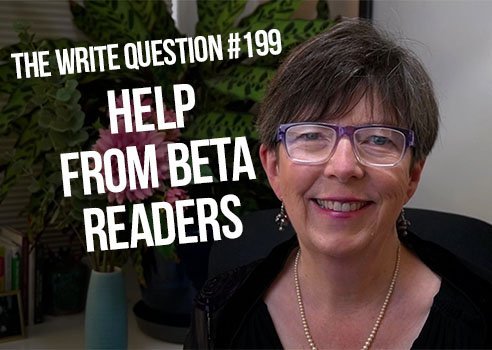Viewing time: 4 mins 11 secs
The Write Question is a weekly video podcast all about writing. Today’s question? How you can get the most help from beta readers? If you have a question you’d like me to answer you can email me, tweet me @pubcoach, or leave a message for me at the Skype account, The Write Question.
Transcript:
How can you get the most help from beta readers? That’s the topic I’m addressing today in The Write Question. I’m Daphne Gray-Grant, the Publication Coach.
I have a question from Fred Estes, a writer based in San Francisco, California. Here’s what he’s asked by email…
“My book is about ready for beta readers. I know this is an important step, but I’m not sure how to organize the process. Thanks for any help you can give me.”
Thanks for the question, Fred. Just in case viewers are unfamiliar with the term ‘beta readers,’ it describes interested and intelligent friends or colleagues who read your book — without pay — and offer you feedback or suggestions.
I first tackled the issue of beta readers back in 2017, in episode #20 of the Write Question. See link, below. In that episode I focused mainly on how to choose the right people and what you should ask them to do.
Today, I want to talk about how to manage their feedback because it’s a surprisingly BIG job.
First, be careful about how many people you invite to be beta readers. I think six to eight is the ideal number but, of course, you need to ask more people than that because some will say ‘no’, or just fail to do the job.
I had about a dozen beta readers for my last book. While they were all wonderful and I was deeply grateful for their help, it was probably more people than I really needed. Also, in my case, many of my readers were professional writers themselves, so their feedback was detailed and particular.
This was terrific, of course, but it did create more work for me. Here’s how I made the job manageable:
Each of my beta readers used ‘track changes’ in Microsoft Word. If you’re unfamiliar with track changes, see link in the show-notes below to learn how it works. I considered their comments one chapter at a time, one reader at a time.
I’d put my master draft and my reader’s draft side-by-side on my computer screen. Starting with chapter 1, if the reader made any suggestions that were no-brainers — for example, if they caught typos — I’d make those changes right away.
Any changes that required thought, however, I put in a note on the side, like this. [See screenshot.] I adopted this strategy for two reasons: First, I wanted to work quickly. Second, I wanted to see what all the other readers had to say before I made any decisions.
Once I’d finished chapter 1 from reader 1, I’d move on to chapter 1 from reader 2. I worked in this fashion until I’d made changes or incorporated notes from all 12 of my readers for that chapter. THEN, I’d spend about a week editing — addressing all of the readers’ concerns and polishing up the chapter.
I found that handling feedback one chapter at a time allowed me to balance the tedious job of data entry — tracking those comments from readers — with the more interesting and challenging work of editing.
One last point: you should never feel obliged to accept every comment made by every beta reader. You are the author and the decision about what to publish remains with you.
Finally, let me wrap up with the words of fantasy writer Kate M. Colby: “Beta readers are generous, book-loving gluttons-for-punishment who are willing to read your unpolished rock and help you shine it into a gem.”
Fred, beta readers will give you suggestions you could never have anticipated. It’s exciting and rewarding to get feedback before your book has even been published.
*
If you’d like to learn more about how to make writing a happier and more rewarding process, check out my latest book Your Happy First Draft. I don’t sell it in bookstores or via Amazon. The only place to buy it is on my website, link on the screen below and in the show notes.


